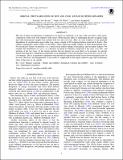| dc.contributor.author | Albrecht, Simon H. | |
| dc.contributor.author | Van Eylen, Vincent | |
| dc.contributor.author | Winn, Joshua Nathan | |
| dc.date.accessioned | 2016-10-21T22:14:22Z | |
| dc.date.available | 2016-10-21T22:14:22Z | |
| dc.date.issued | 2016-06 | |
| dc.date.submitted | 2015-09 | |
| dc.identifier.issn | 1538-4357 | |
| dc.identifier.uri | http://hdl.handle.net/1721.1/104931 | |
| dc.description.abstract | The rate of tidal circularization is predicted to be faster for relatively cool stars with convective outer layers, compared to hotter stars with radiative outer layers. Observing this effect is challenging because it requires large and well-characterized samples that include both hot and cool stars. Here we seek evidence of the predicted dependence of circularization upon stellar type, using a sample of 945 eclipsing binaries observed by Kepler. This sample complements earlier studies of this effect, which employed smaller samples of better-characterized stars. For each Kepler binary we measure e cos ω based on the relative timing of the primary and secondary eclipses. We examine the distribution of e cos ω as a function of period for binaries composed of hot stars, cool stars, and mixtures of the two types. At the shortest periods, hot–hot binaries are most likely to be eccentric; for periods shorter than four days, significant eccentricities occur frequently for hot–hot binaries, but not for hot–cool or cool–cool binaries. This is in qualitative agreement with theoretical expectations based on the slower dissipation rates of hot stars. However, the interpretation of our results is complicated by the largely unknown ages and evolutionary states of the stars in our sample. | en_US |
| dc.description.sponsorship | United States. National Aeronautics and Space Administration. Origins Program (Grant NNX11AG85G) | en_US |
| dc.description.sponsorship | European Research Council (ASTERISK Project. Grant 267864) | en_US |
| dc.description.sponsorship | Danish Council for Independent Research (DFF Sapere Aude Starting Grant 4181-00487B) | en_US |
| dc.language.iso | en_US | |
| dc.publisher | IOP Publishing | en_US |
| dc.relation.isversionof | http://dx.doi.org/10.3847/0004-637x/824/1/15 | en_US |
| dc.rights | Article is made available in accordance with the publisher's policy and may be subject to US copyright law. Please refer to the publisher's site for terms of use. | en_US |
| dc.source | American Astronomical Society | en_US |
| dc.title | Orbital Circularization of Hot and Cool Kepler Eclipsing Binaries | en_US |
| dc.type | Article | en_US |
| dc.identifier.citation | Eylen, Vincent Van, Joshua N. Winn, and Simon Albrecht. “Oribital Circularization of Hot and Cold Kepler Eclipsing Binaries.” The Astrophysical Journal 824.1 (2016): | en_US |
| dc.contributor.department | Massachusetts Institute of Technology. Department of Physics | en_US |
| dc.contributor.department | MIT Kavli Institute for Astrophysics and Space Research | en_US |
| dc.contributor.mitauthor | Albrecht, Simon H. | |
| dc.contributor.mitauthor | Winn, Joshua N. | |
| dc.contributor.mitauthor | Van Eylen, Vincent | |
| dc.relation.journal | The Astrophysical Journal | en_US |
| dc.eprint.version | Final published version | en_US |
| dc.type.uri | http://purl.org/eprint/type/JournalArticle | en_US |
| eprint.status | http://purl.org/eprint/status/PeerReviewed | en_US |
| dspace.orderedauthors | Eylen, Vincent Van; Winn, Joshua N.; Albrecht, Simon | en_US |
| dspace.embargo.terms | N | en_US |
| dc.identifier.orcid | https://orcid.org/0000-0002-4265-047X | |
| mit.license | PUBLISHER_POLICY | en_US |
